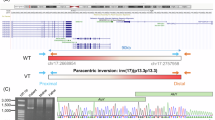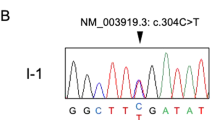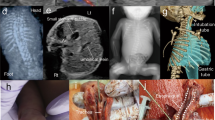Abstract
Mutations in THAP1 have been associated with dystonia 6 (DYT6). THAP1 encodes a transcription factor that represses the expression of DYT1. To further evaluate the mutational spectrum of THAP1 and its associated phenotype, we sequenced THAP1 in 567 patients with focal (n=461), segmental (n=68), or generalized dystonia (n=38). We identified 10 novel variants, including six missense substitutions within the DNA-binding Thanatos-associated protein domain (Arg13His, Lys16Glu, His23Pro, Lys24Glu, Pro26Leu, Ile80Val), a 1bp-deletion downstream of the nuclear localization signal (Asp191Thrfs*9), and three alterations in the untranslated regions. The effect of the missense variants was assessed using prediction tools and luciferase reporter gene assays. This indicated the Ile80Val substitution as a benign variant. The subcellular localization of Asp191Thrfs*9 suggests a disturbed nuclear import for this mutation. Thus, we consider six of the 10 novel variants as pathogenic mutations accounting for a mutation frequency of 1.1%. Mutation carriers presented mainly with early onset dystonia (<12 years in five of six patients). Symptoms started in an arm or neck and spread to become generalized in three patients or segmental in two patients. Speech was affected in four mutation carriers. In conclusion, THAP1 mutations are rare in unselected dystonia patients and functional analysis is necessary to distinguish between benign variants and pathogenic mutations.
Similar content being viewed by others
Log in or create a free account to read this content
Gain free access to this article, as well as selected content from this journal and more on nature.com
or
References
Fahn S, Bressman SB, Marsden CD : Classification of dystonia. Adv Neurol 1998; 78: 1–10.
Fuchs T, Gavarini S, Saunders-Pullman R et al: Mutations in the THAP1 gene are responsible for DYT6 primary torsion dystonia. Nat Genet 2009; 41: 286–288.
Gavarini S, Cayrol C, Fuchs T et al: Direct interaction between causative genes of DYT1 and DYT6 primary dystonia. Ann Neurol 2010; 68: 549–553.
Kaiser FJ, Osmanoric A, Rakovic A et al: The dystonia gene DYT1 is repressed by the transcription factor THAP1 (DYT6). Ann Neurol 2010; 68: 554–559.
Ozelius LJ, Hewett JW, Page CE et al: The early-onset torsion dystonia gene (DYT1) encodes an ATP-binding protein. Nat Genet 1997; 17: 40–48.
Bonetti M, Barzaghi C, Brancati F et al: Mutation screening of the DYT6/THAP1 gene in Italy. Mov Disord 2009; 24: 2424–2427.
Bressman SB, Raymond D, Fuchs T, Heiman GA, Ozelius LJ, Saunders-Pullman R : Mutations in THAP1 (DYT6) in early-onset dystonia: a genetic screening study. Lancet Neurol 2009; 8: 441–446.
Clot F, Grabli D, Burbaud P et al: Screening of the THAP1 gene in patients with early-onset dystonia: myoclonic jerks are part of the dystonia 6 phenotype. Neurogenetics 2011; 12: 87–89.
Djarmati A, Schneider SA, Lohmann K et al: Mutations in THAP1 (DYT6) and generalised dystonia with prominent spasmodic dysphonia: a genetic screening study. Lancet Neurol 2009; 8: 447–452.
Groen JL, Ritz K, Contarino MF et al: DYT6 dystonia: mutation screening, phenotype, and response to deep brain stimulation. Mov Disord 2010; 25: 2420–2427.
Houlden H, Schneider SA, Paudel R et al: THAP1 mutations (DYT6) are an additional cause of early-onset dystonia. Neurology 2010; 74: 846–850.
Söhn AS, Glockle N, Doetzer AD et al: Prevalence of THAP1 sequence variants in German patients with primary dystonia. Mov Disord 2010; 25: 1982–1986.
Xiao J, Zhao Y, Bastian RW et al: Novel THAP1 sequence variants in primary dystonia. Neurology 2010; 74: 229–238.
Zittel S, Moll CK, Bruggemann N et al: Clinical neuroimaging and electrophysiological assessment of three DYT6 dystonia families. Mov Disord 2010; 25: 2405–2412.
Cheng FB, Wan XH, Feng JC, Wang L, Yang YM, Cui LY : Clinical and genetic evaluation of DYT1 and DYT6 primary dystonia in China. Eur J Neurol 2011; 18: 497–503.
De Carvalho Aguiar P, Fuchs T, Borges V et al: Screening of Brazilian families with primary dystonia reveals a novel THAP1 mutation and a de novo TOR1A GAG deletion. Mov Disord 2010; 25: 2854–2857.
Blanchard A, Roubertie A, Simonetta-Moreau M et al: Singular DYT6 phenotypes in association with new THAP1 frameshift mutations. Mov Disord 2011; e-pub ahead of print 25 April 2011.
Osmanovic A, Dendorfer A, Erogullari A et al: Truncating mutations in THAP1 define the nuclear localization signal. Mov Disord 2011; e-pub ahead of print 14 April 2011.
Adzhubei IA, Schmidt S, Peshkin L et al: A method and server for predicting damaging missense mutations. Nat Methods 2010; 7: 248–249.
Ng PC, Henikoff S : SIFT: predicting amino acid changes that affect protein function. Nucleic Acids Res 2003; 31: 3812–3814.
Campagne S, Saurel O, Gervais V, Milon A : Structural determinants of specific DNA-recognition by the THAP zinc finger. Nucleic Acids Res 2010; 38: 3466–3476.
Schneider SA, Ramirez A, Shafiee K et al: Homozygous THAP1 mutations as cause of early-onset generalized dystonia. Mov Disord 2011; 26: 858–861.
Groen JL, Yildirim E, Ritz K et al: THAP1 mutations are infrequent in spasmodic dysphonia. Mov Disord 2011; e-pub ahead of print 29 April 2011.
Xiao J, Zhao Y, Bastian RW et al: The c.-237_236GA>TT THAP1 sequence variant does not increase risk for primary dystonia. Mov Disord 2011; 26: 549–553.
Acknowledgements
This study was supported by governmental and institutional funding, ie by a grant from the Deutsche Forschungsgemeinschaft (to KL, SAS, and FJK; LO 1555/3-1), the Volkswagen Foundation (Lichtenberg Grant to CK), the Hermann and Lilly Schilling Foundation (to CK), and the Else Kröner Fresenius Foundation (to AAK; EKMS).
Author information
Authors and Affiliations
Corresponding author
Ethics declarations
Competing interests
The authors declare no conflict of interest.
Rights and permissions
About this article
Cite this article
Lohmann, K., Uflacker, N., Erogullari, A. et al. Identification and functional analysis of novel THAP1 mutations. Eur J Hum Genet 20, 171–175 (2012). https://doi.org/10.1038/ejhg.2011.159
Received:
Revised:
Accepted:
Published:
Issue date:
DOI: https://doi.org/10.1038/ejhg.2011.159
Keywords
This article is cited by
-
Genetic screening in patients of Meige syndrome and blepharospasm
Neurological Sciences (2022)
-
Isolated dystonia: clinical and genetic updates
Journal of Neural Transmission (2021)
-
Tremor in Primary Monogenic Dystonia
Current Neurology and Neuroscience Reports (2021)
-
In-depth Characterization of the Homodimerization Domain of the Transcription Factor THAP1 and Dystonia-Causing Mutations Therein
Journal of Molecular Neuroscience (2017)
-
Update on the Genetics of Dystonia
Current Neurology and Neuroscience Reports (2017)



